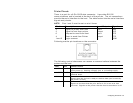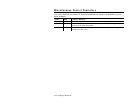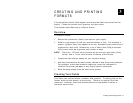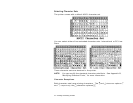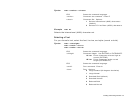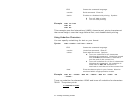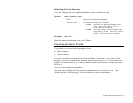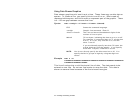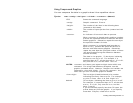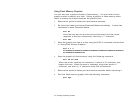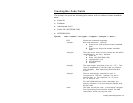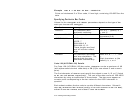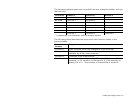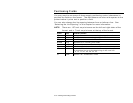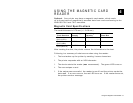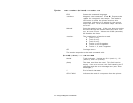Creating and Printing Formats 3-7
Using Compressed Graphics
You can compress the data in a graphic when it has repetitive values.
Syntax ESC-<cmdg>-<height>-<width>-<counter>-#data#
ESC Starts the command language.
<cmdg> Graphic command. Enter v.
<height> The number of dot lines in the following data
(entered as 8-bit data).
<width> The number of bytes per dot line (entered as 8-bit
data).
<counter> An indicator of how much data to process.
When <counter> is signed (and a positive number),
process the specified amount of data as with data
stream graphics. Otherwise, repeat the next byte
the specified number of times.
When <counter> is unsigned (and less than or
equal to 127), process the specified amount of
data as with data stream graphics. Otherwise,
repeat the next byte the specified number of times
(the specification being the difference between
counter and 256).
#data# The data in the graphic. 72 hex bytes, indicating
the dots to turn on or off. For example, if a
specified byte is FF, all the dots are on. If it is 01,
only one dot is on, and the other 7 are off.
NOTES: <counter> and <data> can repeat multiple times within one
command. For using Flash Memoroy Graphics, use the
graphic command above. However, <height> and <width> are
replaced by <low> and <high>. Do not use <counter>, but
make sure you still include the graphic’s #data#.
<low><high> The hex digits (listed backward) of a number
indicating how many lines to print. For example,
to print 10 lines, <low> is A, and <high> is 0.
#data# 72 hex bytes, indicating the dots to turn on or off.
For example, if a specified byte is FF, all the dots
are on. If it is 01, only one dot is on, and the
other 7 are off.
If you accidentally specify less than 72 bytes, the
printer does not print the graphic. If you specify
more than 72 bytes, a fatal error occurs.



